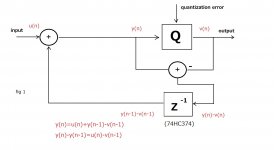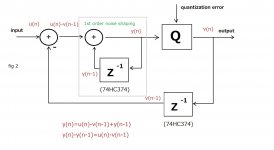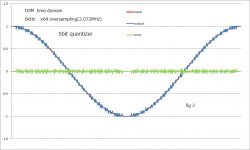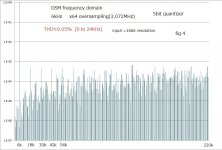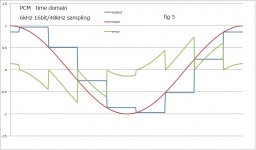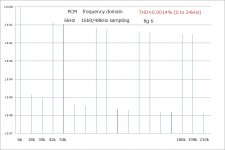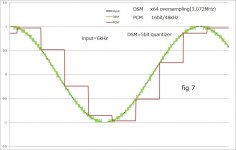I recently need to design DSM for FPGA. You can calculate required optimum coefficients of DSM from the book "Understanding Delta-Sigma Data Converters." But the phisical meaning of DSM is not easy to understand if you read the book. My conclusion is that almost every explanation about DSM is 1bit and historical one, e.g., from delta-modulation to delta-sigma modulation. It's historically correct but educationally incorrect. I can hardly understand the principle of DSM from such a conventional explanation. Here is my analysis of DSM to understand its physical meaning. It could be a reference for those who want to struggle with DSM.
A 1st order DSM is simple NFB system like fig 1. Fig 1 means quantization error(y -v
-v ) is negative feedbacked to the quantizer. It consists of a quantizer, an adder, and a delay(same as hc374 if 8bits). Z^(-1) is a very common module in the discrete time system. It is the same function as one clock delay. That's why y
) is negative feedbacked to the quantizer. It consists of a quantizer, an adder, and a delay(same as hc374 if 8bits). Z^(-1) is a very common module in the discrete time system. It is the same function as one clock delay. That's why y *Z^(-1)=y(n-1), y(n-1) means previous data of y
*Z^(-1)=y(n-1), y(n-1) means previous data of y by one clock. With this equation, you can calculate the input of quantizer y
by one clock. With this equation, you can calculate the input of quantizer y . y
. y =u
=u +y(n-1)-v(n-1)
+y(n-1)-v(n-1)
Fig 2 is a typical 1st order DSM which you can see in a textbook. It consists of a quantizer, an adder and noise shaping filter. You can't even imagine its physical meaning from this. But this functions precisely same as fig 1. Because the input of quantizer y is equal to fig 1.
is equal to fig 1.
As long as you know y *Z^(-1)=y(n-1), you can calculate y
*Z^(-1)=y(n-1), you can calculate y . y
. y =u
=u -v(n-1)+y(n-1).
-v(n-1)+y(n-1).
That's why you can use fig 1, which has clear physical meaning, to analyze DSM instead of fig 2 which is very vague. Fig 3 and fig 4 are SIM of fig 1 done by Excel. A discrete time system can be expressed in a recursive formula. You don't need to have the knowledge of math to SIM if you use a spreadsheet because the spreadsheet is exactly a recursive formula. Fig 3 uses 5bit quantizer. 1-bit quantizer which doesn't have a common characteristic of DSM is not a good choice to SIM.
The output of the quantizer(blue) is easy to imagine because fig 1 has NFB of the difference. It is above the input or below the input by (1/32)FS. The difference(quantization error) is between (1/32) and -(1/32). The higher the quantizer resolution is, the lower the difference is. The toggle frequency of the difference is almost same as the sampling clock (48*64=3.072MHz). This is the physical meaning of oversampling. The higher OSR is, the higher noise spectrum is. That's why high OSR is preferable for low THD. Fig 4 is FFT of the output. Even a simple 1st order DSM can achieve 0.05% THD. A typical DSM like fig 2, of course, has the same THD. If you use 1bit quantizer, THD is not good as this but not so bad. If you use fig 1 to analyze DSM, the meaning of quantizer and OSR are easy to understand visually. Fig 2 with 1bit quantizer is terrible, IMHO.
Fig 5 and fig 6 are the same SIM in PCM. It apparently looks the error(green) of PCM is larger than DSM. But THD is 0.0014% which is almost same as 16bit distortion. PCM has relatively high amplitude noise spectrum near fundamental(6kHz). But in Nyquist range(0 to 24kHz),it has one spectrum(18kHz). That's why 16bit PCM is better than DSM of 5bit quantizer and 64OSR. If you compare DSM and PCM like fig 7, it apparently looks DSM is more precise than PCM. But THD of PCM is better than DSM. PCM artfully utilizes harmonics. PCM is also mysterious for me. DSM utilizes high order noise shaping on the other hand to improve THD. This is also artful.
A 1st order DSM is simple NFB system like fig 1. Fig 1 means quantization error(y
Fig 2 is a typical 1st order DSM which you can see in a textbook. It consists of a quantizer, an adder and noise shaping filter. You can't even imagine its physical meaning from this. But this functions precisely same as fig 1. Because the input of quantizer y
As long as you know y
That's why you can use fig 1, which has clear physical meaning, to analyze DSM instead of fig 2 which is very vague. Fig 3 and fig 4 are SIM of fig 1 done by Excel. A discrete time system can be expressed in a recursive formula. You don't need to have the knowledge of math to SIM if you use a spreadsheet because the spreadsheet is exactly a recursive formula. Fig 3 uses 5bit quantizer. 1-bit quantizer which doesn't have a common characteristic of DSM is not a good choice to SIM.
The output of the quantizer(blue) is easy to imagine because fig 1 has NFB of the difference. It is above the input or below the input by (1/32)FS. The difference(quantization error) is between (1/32) and -(1/32). The higher the quantizer resolution is, the lower the difference is. The toggle frequency of the difference is almost same as the sampling clock (48*64=3.072MHz). This is the physical meaning of oversampling. The higher OSR is, the higher noise spectrum is. That's why high OSR is preferable for low THD. Fig 4 is FFT of the output. Even a simple 1st order DSM can achieve 0.05% THD. A typical DSM like fig 2, of course, has the same THD. If you use 1bit quantizer, THD is not good as this but not so bad. If you use fig 1 to analyze DSM, the meaning of quantizer and OSR are easy to understand visually. Fig 2 with 1bit quantizer is terrible, IMHO.
Fig 5 and fig 6 are the same SIM in PCM. It apparently looks the error(green) of PCM is larger than DSM. But THD is 0.0014% which is almost same as 16bit distortion. PCM has relatively high amplitude noise spectrum near fundamental(6kHz). But in Nyquist range(0 to 24kHz),it has one spectrum(18kHz). That's why 16bit PCM is better than DSM of 5bit quantizer and 64OSR. If you compare DSM and PCM like fig 7, it apparently looks DSM is more precise than PCM. But THD of PCM is better than DSM. PCM artfully utilizes harmonics. PCM is also mysterious for me. DSM utilizes high order noise shaping on the other hand to improve THD. This is also artful.
